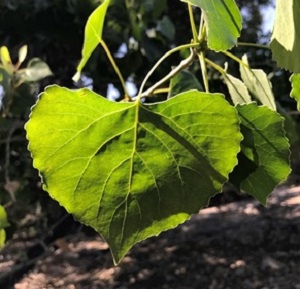 Cottonwood leaves alongside Tierra Blanca Creek, near Kingston, NM in September
Cottonwood leaves alongside Tierra Blanca Creek, near Kingston, NM in September
(photo credit M. Thompson).
Question:
What is your favorite tree species?
- Adan O., Albuquerque, NM
Answer:
Right now, my favorite tree is the alligator juniper outside my office window in Los Lunas, with sparrows flitting around the branches. My favorite tree when I lived in Las Cruces was the peach tree that yielded 40+ lb of deliciousness each year. With temperatures in the nineties here this week, my favorite tree at home is the huge cottonwood that shades most of my back yard—unless I'm in the front yard, where a green ash does all of the shady work and quickly takes the favorite tree superlative in my book. But would I recommend that people plant cottonwoods in their yards? Or green ash? Or alligator juniper? Not necessarily. I don't recommend cottonwood species in New Mexico landscapes unless the location is so close to the river that the water table is only a few feet deep. And I'm not recommending new plantings of ash trees nowadays because of the pests that plague them and the potential introduction of the emerald ash borer from neighboring states. I'm not saying ash trees should never be planted again, it's just not one I'm encouraging, even though many existing specimens are great trees.
The key is selecting the right tree for the right place. In fact, "right tree, right place" is the slogan for arborists nationwide. It's a simple concept, and yet too often ignored. The Arbor Day Foundation website (www.arborday.org) lists things to consider when picking a tree. One of the first considerations is the expected tree size at maturity, both above and below ground. If your tree gets too tall or wide for the space, pruning needs may be constant from year to year. Sure, there are good reasons to prune—mainly safety hazards due to damaged branches or managing fruit tree size and fruit load—but every single pruning cut requires energy from the tree to seal the wound and could be a site of infection. So it's better to plant the bigger trees in spaces that will be able to sustain that size without pruning, and in space-limited areas to plant trees (or shrubs) that will be a good size at maturity. If you do need to prune, be sure you understand the best and most recent recommended practices. Check out the NMSU Extension Guide H-156, "Tree Pruning Techniques" (http://aces.nmsu.edu/pubs/_h/H156.pdf). One of my favorite pruning quotes is by the late Dr. Al Shigo, biologist and plant pathologist with the U.S. Forest Service, who said, "People who prune the old-fashioned way should be made to go to an old-fashioned dentist."
Rate of growth is another thing to think about when selecting the right tree for the right place because slow-growing species typically live longer than fast-growing species. Trees that grow very quickly are more likely to be shorter-lived, are more prone to branch breakage, and may have higher susceptibility to pests or disease.
Of course there are lots of other factors to consider when selecting your future favorite tree, including cold hardiness, heat tolerance, soil preference, sun exposure, and irrigation requirements, just to name a few of the biggies.
Ideally, a tree will live a very long life in the exact place you plant it, so take time to choose wisely. The NMSU Guides H-328, "Selecting Ornamental Trees for New Mexico" (http://aces.nmsu.edu/pubs/_h/H328.pdf), and H-426, "Shade Trees for New Mexico" (http://aces.nmsu.edu/pubs/_h/H426.pdf), are a great place to start.
You can see how quickly I dodged the "What's your favorite tree?" question. I'm generally a fan of rating favorites, but I worry that picking a favorite tree for New Mexico doesn't allow room to consider how important species diversity is for long-term environmental health and sustainability. Any tree that is appropriately selected, planted, mulched, and irrigated has a good chance of being my favorite in any given moment.
Send gardening questions to Southwest Yard and Garden - Attn: Dr. Marisa Thompson at desertblooms@nmsu.edu, or at the NM Desert Blooms Facebook page (@NMDesertBlooms)
Please copy your County Extension Agent (http://aces.nmsu.edu/county/) and indicate your county of residence when you submit your question!
For more gardening information, visit the NMSU Extension Horticulture page at Desert Blooms (http://desertblooms.nmsu.edu/) and the NMSU Horticulture Publications page at http://aces.nmsu.edu/pubs/_h/.
Marisa Y. Thompson, PhD, is the Extension Horticulture Specialist, in the Department of Extension Plant Sciences at the New Mexico State University Los Lunas Agricultural Science Center, office: 505- 865-7340, ext. 113.